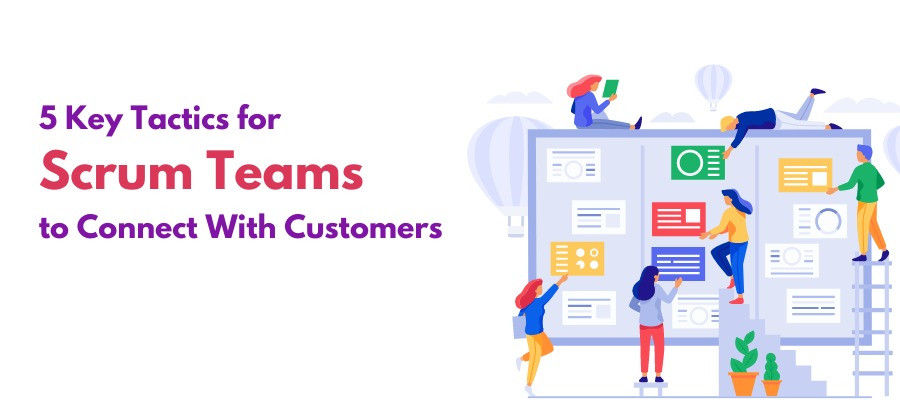5 Key Tactics for Scrum Teams to Connect With Customers

Scrum teams must craft a customer-centric approach leveraging the latest technology and techniques to build meaningful customer relationships. This requires teams to stay abreast of customer trends and preferences and to proactively develop solutions that meet their demands. To do this, teams must establish robust communication channels with customers and listen to their feedback to ensure solutions are tailored to their needs. Additionally, teams must experiment and innovate to stay ahead of customer expectations, offering unique and valuable experiences that keep customers coming back.
The following are five key tactics Scrum teams can use to stay connected with customers and build meaningful relationships:
1. Product Discovery
Scrum teams employ Product Discovery to guarantee that their end result can really be developed, is usable, and provides value to customers. Scrum teams are better equipped to evaluate the product's viability, usefulness, and value if they first define and test a Minimal Viable Product (MVP). By doing a minimum viable product (MVP) exercise, they may determine which features should be included and which should be cut before developing a prototype to test with actual customers. This is crucial for meeting client expectations and completing on-time product deliveries.
2. Maintaining Interest and Value for the Customers
Staying connected with customers is critical for Scrum teams to achieve success. To ensure this connection, teams should stay abreast of customer trends and preferences and employ an Agile approach to product development. Additionally, customer feedback should be considered when designing a product, allowing the team to craft a solution tailored to the customers' needs. Listening to customer grievances is also beneficial, as it allows teams to gain insights and develop creative solutions to any issues. By understanding the needs and wants of customers, Scrum teams can create products tailored to their needs, ultimately leading to customer satisfaction.
3. Understanding Customers' Perspectives
For Scrum teams to be successful, they must always strive to keep their customers at the heart of their development process. This means continually engaging with customers to understand their preferences and needs and incorporating their feedback into the product story. By creating a product that caters to customers' needs, teams can build a connection between the customer and the product that drives customer satisfaction and helps ensure the product's success. Doing so requires teams to be constantly mindful of the customer and to keep their customer's perspectives in focus throughout the entire product development cycle.
4. Focus on Quality and Establishing Trust
Scrum teams must focus on delivering exceptional products that meet customer needs and exceed their expectations. This requires diligent effort to monitor customer perspectives and preferences and develop innovative solutions aligning with their evolving demands. Such proactive efforts to deliver high-quality products and services will foster trust between teams and customers, ultimately resulting in customer loyalty. To accomplish this, teams must be committed to delivering reliable, intuitive, and value-adding products that are constantly updated and improved to meet changing customer needs.
5. Leveraging Technology to Enhance the Customer Experience
Scrum teams may use technology to provide customers with a more specialized service. Customers may receive a more personalized experience that's suited to their needs thanks to the use of AI and ML to automate interactions with the company and evaluate feedback data. When clients get information and products that are more relevant to them, it might assist in creating lasting relationships with them.
In addition, teams may utilize customer insights to design individualized campaigns and product offers based on the specific requirements of their customers. This gives clients the most current and pertinent data for making educated purchases. Using such a technological approach, Scrum teams may improve the customer experience and build lasting bonds with their clients.
These five tactics are essential for Scrum teams to stay connected with customers and build meaningful relationships.
Why is it necessary to improve teamwork with Scrum methods?
The capacity to cooperate and work together productively is becoming increasingly important to the survival and growth of any firm in today's dynamic and competitive marketplace. Scrum techniques provide a useful structure for cooperation and collaboration, allowing members to work together more effectively and efficiently to produce better outcomes.
Scrum techniques are intended to facilitate the subdivision of large projects into smaller, more manageable pieces, allowing teams to more easily detect and address problems, set priorities, and achieve peak efficiency. As a bonus, when teams employ Scrum techniques, they build trust and cooperation by sharing information and assets. The result is a more cohesive unit with an increased capacity for problem-solving and clearer lines of communication, which are crucial in today's competitive corporate world.
Conclusion
By understanding customer perspectives, focusing on product quality, and leveraging technology to enhance customer experience, Scrum teams will be able to create valuable solutions that meet the needs of their customers. Doing so will ultimately result in customer satisfaction and loyalty.
Reference
- https://dzone.com/articles/5-key-tactics-for-scrum-teams-to-connect-with-thei



